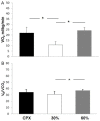Hemodynamic and metabolic response during dynamic and resistance exercise in different intensities: a cross-sectional study on implications of intensity on safety and symptoms in patients with coronary disease
- PMID: 27335689
- PMCID: PMC4913213
Hemodynamic and metabolic response during dynamic and resistance exercise in different intensities: a cross-sectional study on implications of intensity on safety and symptoms in patients with coronary disease
Abstract
Resistance (RE) and aerobic exercise (AE) can promote hemodynamic, physiologic and clinical modifications in coronary artery disease (CAD) patients. The aim of the study is to assess key physiologic and clinical responses during RE at 30% and 60% of 1-RM on a 45° leg press and to compare responses during AE. We evaluated fifteen male subjects with coronary artery disease (60.8±4.7 years) that performed the following tests: (1) incremental AE test on cycle ergometer; (2) 1-RM test on a leg press at 45°; (3) and RE at 30% and 60% of 1-RM for 24 repetitions. Peak cardiac output (CO), heart rate (HR), oxygen consumption (VO2), carbon dioxide production (VCO2) and the minute ventilation (VE, L/min)/VCO2 ration were measured. We found that both AE and RE at 60% of aerobic and resistance capacity elicited similar hemodynamic and ventilatory responses (p>0.05). However, RE at 30% 1-RM showed more attenuated responses of VO2, VE/VCO2, HR and CO when compared with 60% of aerobic and resistance capacity. Interestingly, the number, percentage and the severity of arrhythmias were higher at 60% 1-RM (P<0.05). Our data suggest that high repetition sets of RE at 60% 1-RM appears to result in hemodynamic, ventilatory, and metabolic changes equivalent to those observed during AE at a comparable intensity.
Keywords: Cardiac rehabilitation; coronary artery disease; resistance exercise.
Figures





References
-
- Williams MA, Haskell WL, Ades PA, Amsterdam EA, Bittner V, Franklin BA, Gulanick M, Laing ST, Stewart KJ American Heart Association Council on Clinical Cardiology; American Heart Association Council on Nutrition, Physical Activity, and Metabolism. Resistance exercise in individuals with and without cardiovascular disease: 2007 update: a scientific statement from the American Heart Association Council on Clinical Cardiology and Council on Nutrition, Physical Activity, and Metabolism. Circulation. 2007;116:572–84. - PubMed
-
- American College of Sports Medicine. ACSM’s Guidelines for Exercise Testing and Prescription. 6th ed. Baltimore, Md: Lippincott Williams & Wilkins; 2000.
-
- Whaley MH, Brubaker PH, Otto RM, Armstrong LE. Acsm’s Guidelines for Exercise Testing and Prescription. Philadelphia, Pa: Lippincott Williams & Wilkins; 2006.
-
- American Association of Cardiovascular and Pulmonary Rehabilitation. Guidelines for Cardiac Rehabilitation and Secondary Prevention Programs. 4th ed. Champaign, Ill: Human Kinetics; 2004.
-
- American Geriatrics Society Panel on Exercise and Osteoarthritis. Exercise prescription for older adults with osteoarthritis pain: consensus practice recommendations: a supplement to the AGS Clinical Practice Guidelines on the management of chronic pain in older adults. J Am Geriatr Soc. 2001;49:808–823. - PubMed
LinkOut - more resources
Full Text Sources
Medical
Miscellaneous
